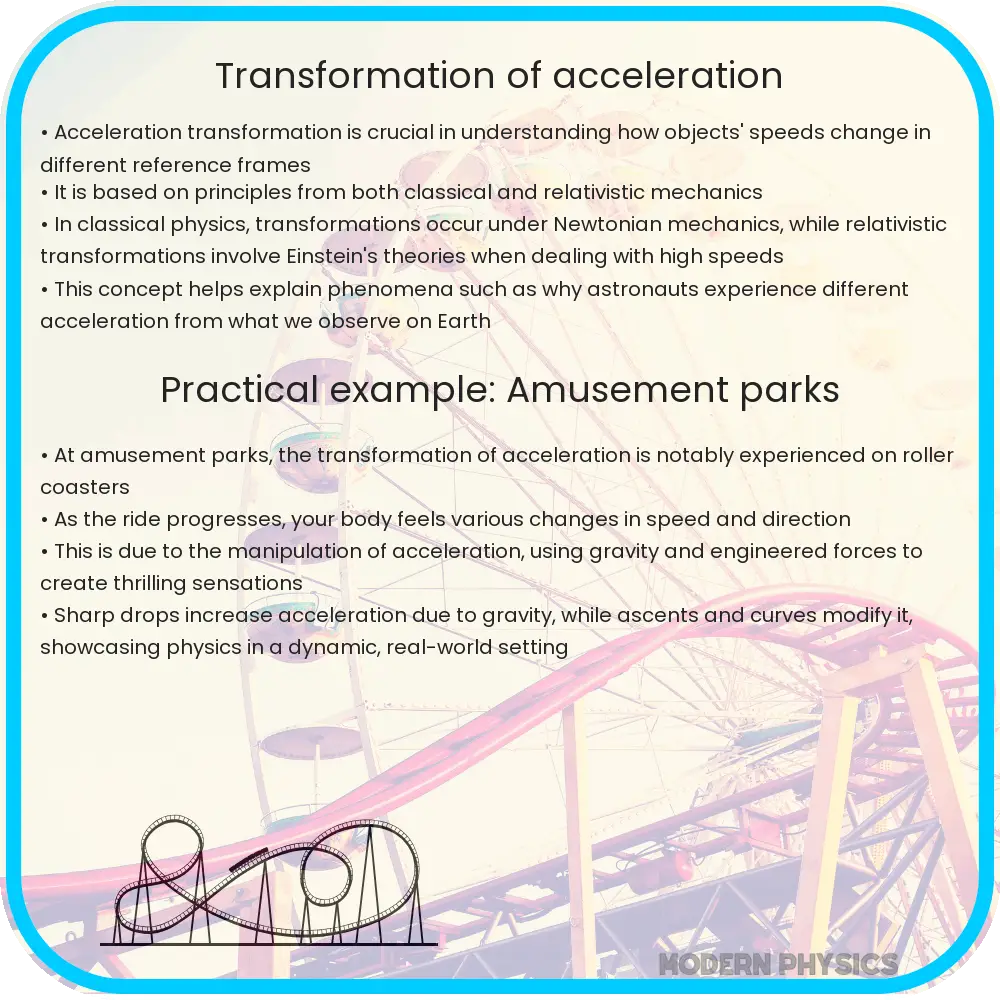Explore the transformation of acceleration in Special Relativity, understanding Lorentz transformations and their impact on physics and cosmology.

Understanding the Transformation of Acceleration in Special Relativity
Special Relativity, a theory proposed by Albert Einstein in 1905, revolutionized the way we understand space and time. At its heart, it addresses how measurements of space and time are altered by motion, especially at speeds close to that of light. One intriguing aspect of this theory is the transformation of acceleration, which differs significantly from the classical Newtonian mechanics perspective.
The Basics of Special Relativity
Before delving into the transformation of acceleration, it’s essential to grasp some fundamental concepts of Special Relativity. The theory is built on two key postulates:
- The Principle of Relativity: The laws of physics are the same in all inertial frames of reference, which are frames moving at constant velocity relative to each other.
- The Constancy of the Speed of Light: The speed of light in vacuum is the same for all observers, regardless of the motion of the light source or observer.
These postulates lead to several remarkable phenomena, such as time dilation and length contraction, but they also have profound implications for how we perceive acceleration.
Transformation of Acceleration
In Newtonian mechanics, acceleration is simply the rate of change of velocity. However, in Special Relativity, things are more complex. The transformation of acceleration between different inertial frames of reference is not as straightforward as the transformation of velocity.
One of the key concepts to understand is that in Special Relativity, acceleration is not invariant. This means that different observers, in different inertial frames, may disagree on the value of an object’s acceleration. This is in stark contrast to the speed of light, which is invariant and observed to be the same in all inertial frames.
The transformation of acceleration involves Lorentz transformations, which are mathematical formulas used to convert measurements like time, space, and velocity from one frame of reference to another. These transformations take into account the relative velocity between the frames and the speed of light, leading to results that can seem counterintuitive from a classical perspective.
For instance, an object accelerating in one frame may appear to have a different rate of acceleration in another frame. This is not only due to the relative velocity between the frames but also because time itself is experienced differently in each frame, a phenomenon known as time dilation.
This complexity makes the transformation of acceleration a fascinating subject within the realm of Special Relativity, offering insights into the fundamental nature of reality as perceived at high velocities.
Lorentz Transformations and Acceleration
To fully comprehend the transformation of acceleration in Special Relativity, we must delve into Lorentz transformations. These mathematical equations adjust the coordinates of space and time from one inertial frame to another. Notably, Lorentz transformations reveal that time and space are interwoven, a concept central to understanding why acceleration transforms differently in various reference frames.
For instance, consider an object moving with a constant acceleration in one frame of reference. Due to Lorentz transformations, an observer in another frame will perceive this acceleration differently. This discrepancy arises because the time intervals and spatial distances are not the same in both frames, leading to different measurements of velocity changes over time.
Practical Implications and Challenges
The transformation of acceleration in Special Relativity is not just a theoretical concept but has practical implications, especially in the field of high-energy physics and astrophysics. For example, particles accelerated in a collider experience relativistic effects, and their behavior can only be accurately predicted using the principles of Special Relativity. Similarly, understanding the dynamics of objects moving at relativistic speeds in outer space requires a firm grasp of how acceleration transforms under this theory.
However, the application of these principles is challenging. In the realm of relativistic speeds, intuitive notions based on everyday experiences fall short. Predictions and calculations require careful consideration of the relative motion of observers and the invariant nature of the speed of light.
Conclusion
The transformation of acceleration in Special Relativity is a fascinating and complex aspect of modern physics. It challenges our classical notions of time and space, highlighting the intricate relationship between these dimensions. While Lorentz transformations provide the mathematical foundation for understanding these changes, the practical application in fields like astrophysics and high-energy physics underscores the importance of this theory in exploring and understanding our universe. Special Relativity, therefore, not only enriches our knowledge of fundamental physics but also continually inspires awe and curiosity about the nature of the cosmos.
